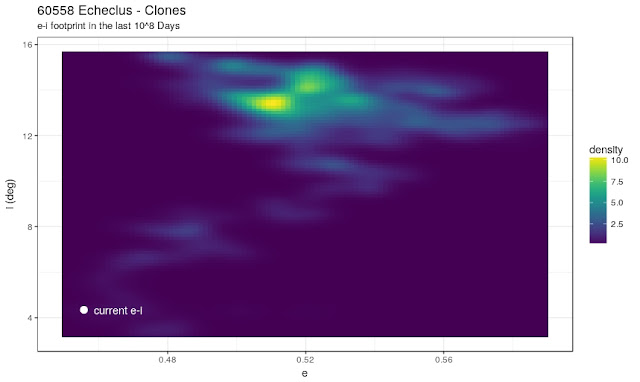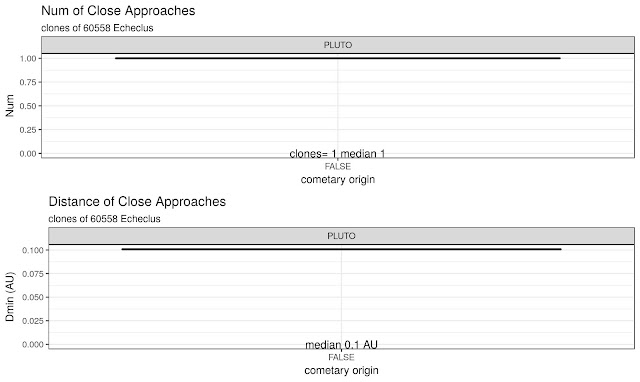A coma was recently detected as far as 400,000 km from centaur 2014 OG392 by NAU researchers (click here to access their paper).
Following this discovery, the centaur was given a comet designation: C/2014 OG392
| C/2014 OG392 (PANSTARRS) |
| Classification: Chiron-type Comet SPK-ID: 1003735 |
| [ Ephemeris | Orbit Diagram | Orbital Elements | Mission Design | Physical Parameters ] |
| Orbital Elements at Epoch 2457785.5 (2017-Feb-01.0) TDB Reference: JPL 14 (heliocentric ecliptic J2000)
| Orbit Determination Parameters
Additional Information
|
I tried to investigate the cometary nature running a backward integration using Mercury6 software by E. Chambers.
I generated 100 clones trying to achieve the same nominal orbital parameters and uncertainty as above.
| Clones | Target | ||||
|---|---|---|---|---|---|
| mean | sd | mean | sd | ||
| q | 9.95787410878 | 6.694624e-05 | 9.95787503182 | 6.704e-05 | |
| e | 0.18043892764 | 7.50991e-06 | 0.18043898283 | 7.4417e-06 | |
| i | 9.04614599334 | 4.699782e-05 | 9.04614423635 | 4.6644e-05 | |
| peri | 254.78819470552 | 0.00271470415 | 254.78814346806 | 0.0027215 | |
| node | 145.86454031167 | 0.0001548109 | 145.86453843292 | 0.00015579 | |
| tp | 2459571.21974672 | 0.07635106812 | 2459571.21814341 | 0.076746 | |
Simulation parameters
integration algorithm: Bulirsch-Stoer
ejection distance from the solar system: 100 au
simulation start time: 2020 A.D.
simulation stop time: -1d8 (about -274K years BC)
Simulation results
A "true" cometary origin is confirmed for 29 clones, in fact, they entered the solar system from a distance greater than 100 au according to this arrival time distribution
In order to read the following plots, you need to know that:
the simulated time is divided into 50 intervals , in every interval and for every clone I have calculated the min perihelium and then I have plotted the interquantile distribution in that interval.
Similar approach for max aphelium, max eccentricity, ... etc.
Perihelium q
Aphelium QEccentricity eInclination i
Peri w
Node om
Kind Regards,
Alessandro Odasso
























